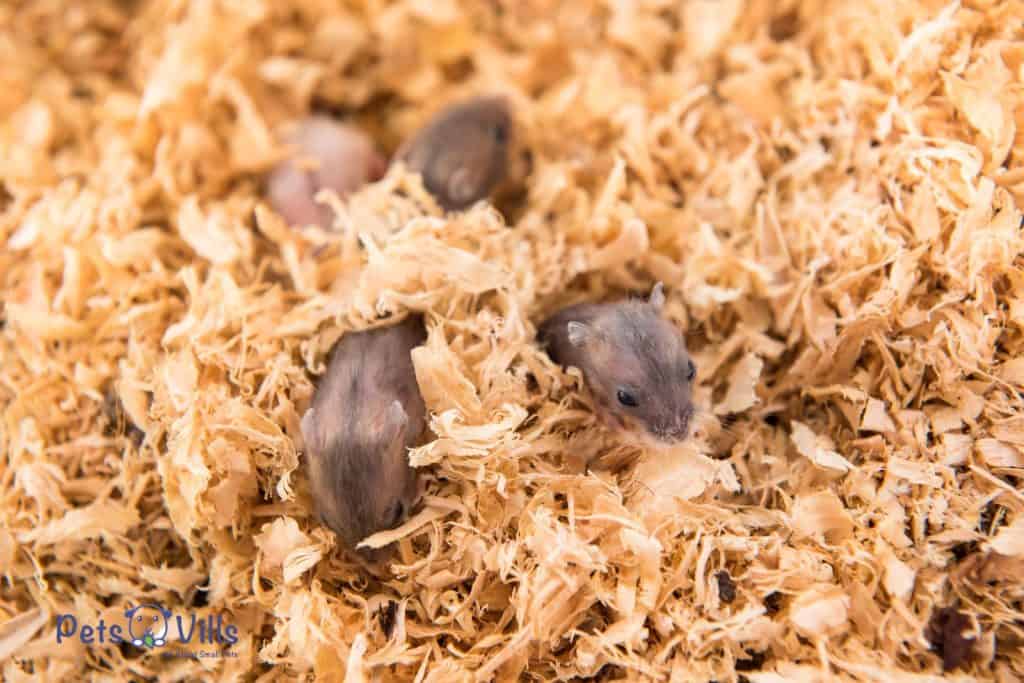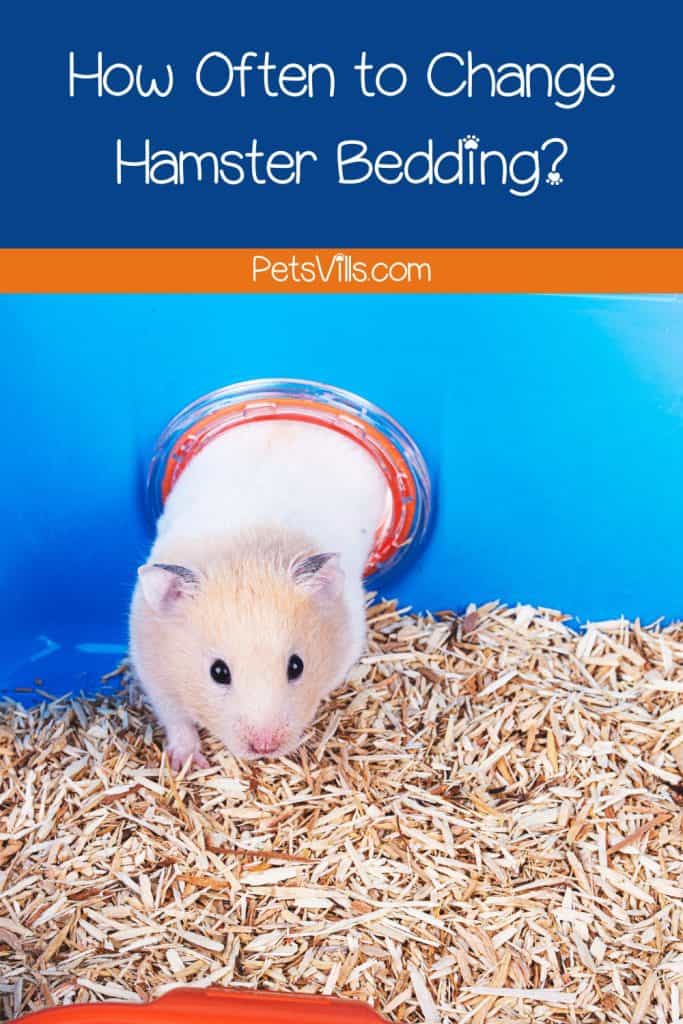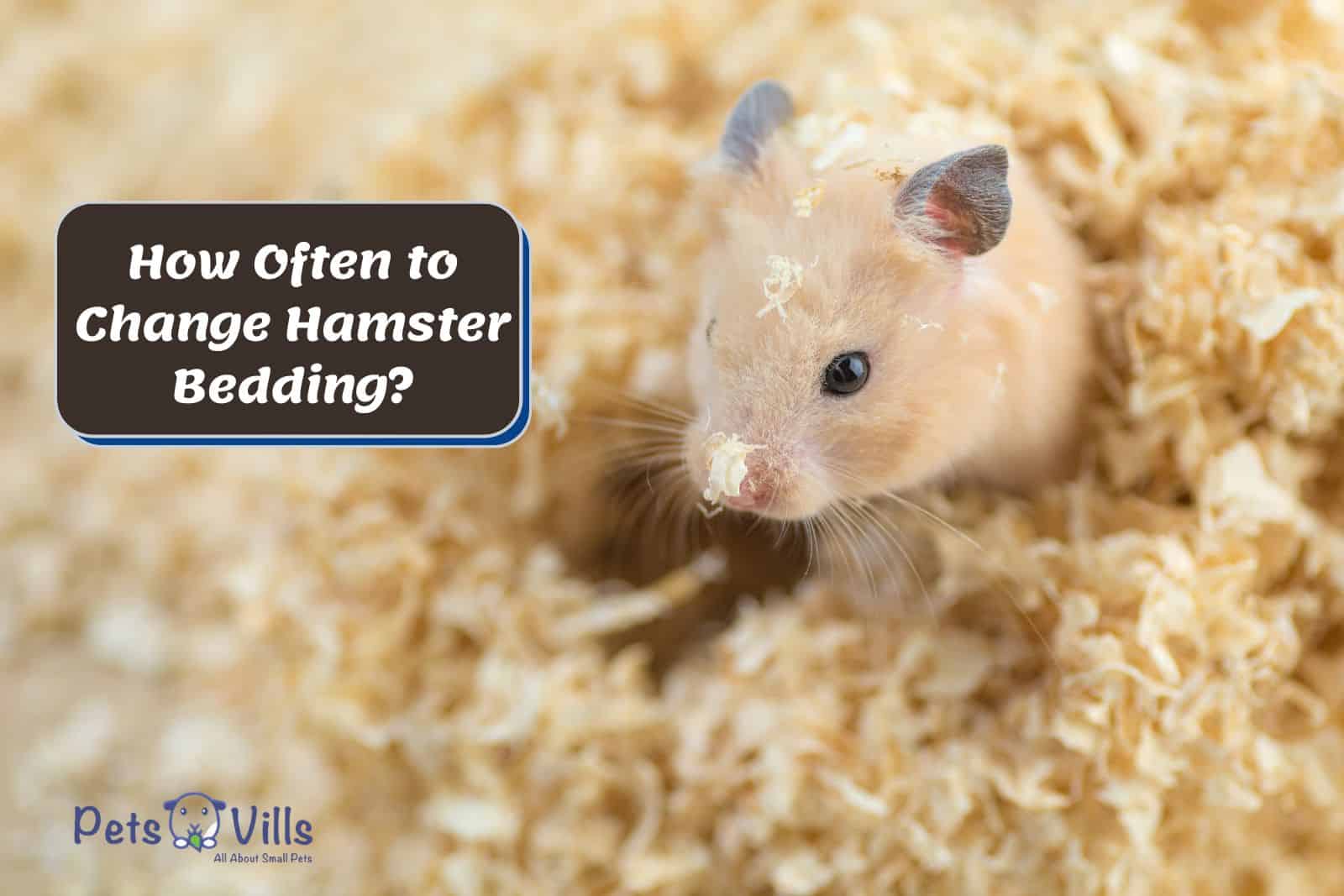How often to change hamster bedding? It’s a question that has haunted many prospective hamster owners over the years.
After all, nobody is thrilled with the idea of frequent cleaning of soiled bedding.
So I thought it’d help to rip off the band-aid with a guide about hamster bedding.
Read on, and you’ll soon learn if taking care of a hamster is the right move.
Table of Contents
Quick Summary
- There isn’t a specific timetable for complete hamster bedding changes. Instead, you spot-check the cage daily and replace any spoiled or wet bedding.
- Complete bedding changes will need to happen when the bedding becomes too soiled (about 2/3’s). Another situation will be if they had mites, fleas, or ringworm.
- Changing hamster bedding keeps your hamster healthy and their cage hygienic by preventing illnesses, diseases, and mold/mildew growth.
- Owners can expect the changing out process not to take much effort. It’ll require removing spoiled bedding, feces, and leftover food. Then, place in a new batch of bedding.
When Is It Necessary to Change Your Hamster’s Bedding?
Offering a general time frame for changing out all hamster bedding is difficult. But it doesn’t matter because it’s a better idea to spot-check and change out spoiled spots daily.
At the same time, remove any feces or old food remains to avoid other potential issues. This process will keep your hamster’s environment clean and safe.
But you’re probably wondering why an owner wouldn’t change it all. A few people even argue that entire change-outs should be a weekly occurrence.
However, I find this sets a bad precedent and stresses out your hamster. Hamsters enjoy a familiar environment, so complete bedding change-outs cause stress.
In fact, “stressed hamsters are likely to become ill” (1). So it is best to avoid stressors as much as possible.
Sticking with our spot cleaning plan is a simple way of doing it. For example, it’ll provide your furry friend with the best of both worlds: clean bedding and a familiar environment.
Is There a Situation Where You Need to Replace All the Bedding?
Of course, there are situations where all the bedding does need replacing. The most obvious is when a large area of your hamster’s bedding becomes soiled or too dirty.

It then becomes unavoidable to replace all the bedding. If it’s anywhere over 2/3’s of the bedding, it’s time for a total replacement.
You also may have to change it out after a vet visit. It’ll occur when your vet notices one of the following issues:
- Ringworm
- Fleas
- Parasites
- Mites
- Mold
- Mildew
Anyone who’s in this predicament should change all the bedding immediately. Honestly, get right to it once you enter your home.
These conditions can affect your hamster’s health drastically. So it’s necessary to eliminate all the bedding and eradicate the problem.
Also Read: Can Hamsters Have Pine Bedding?
Hey there, fellow hamster lovers! Looking for the perfect home for your furry friend? You’re in luck – in this video, we’ll show you the best hamster cages on the market:
3 Reasons Why You Must Change Hamster Bedding
Some people may wonder why a hamster needs its bedding changed so often. After all, these tiny critters are supposed to be relatively low-maintenance pets.
So I thought I’d clear up some things by showing you why it’s so crucial. Let’s take a quick look at the three primary reasons to keep up-to-date on hamster bedding maintenance:
1. Spoiled Bedding Is Gross
The first reason is relatively easy to understand. Leaving behind soiled bedding inside a hamster’s cage is unhygienic and gross.
In other words, you wouldn’t want to be in a room full of dirty bedding, feces, and leftover food. Neither does your hammy!
2. Helps Prevent Diseases and Illnesses
Changing out bedding regularly will also help keep your hammy healthy. For instance, spoiled bedding represents a perfect area for microbes to grow.
So if it isn’t changed, it leaves your hamster vulnerable to many illnesses and diseases. A very common health issue associated with dirty bedding would be wet tail (3).
You’re then leaving your hamster in a very precarious situation.
3. Stops Mold or Mildew Growth
Our little hamsters are known for dropping water on their bedding. As a result, it becomes an ideal place for mildew and mold to grow (4).
It’s why owners must change out any water bedding that appears inside the hamster cage. These mold and mildew build-ups can be serious health risks if they don’t.
Also Check: Can I Use Hay for Hamster Bedding?
Here are some of the best hypoallergenic beddings.
How to Clean Hamster Bedding?
It seems to make sense that I now discuss how to clean hamster bedding. Thankfully, the process isn’t too tricky, whether spot cleaning or doing a total bedding replacement:
Spot Cleaning and Total Bedding Replacement Steps:
- Place your hamster in a safe secondary location (more on where later).
- Put on some gloves and find a small shovel. Use the shovel to scoop out your hamster’s spoiled bedding.
- Anyone who notices leftover food on the bedding should also remove it. This food can cause a pungent cage odor and cause various hygiene concerns if left. But you don’t have to remove the bedding under it unless it has become wet or moist.
- Proceed to examine bedding around the water bowl or water bottle area. These types of bedding will be prone to get wet from splashing. So any moist or damp bedding within this area will need removal to stop mold and mildew growth.
- Place all the spoiled/wet bedding into a plastic bag for disposal. Check all the other equipment and take out anything with signs of spoilage.
- If only spot cleaning, proceed to clean spoiled cage equipment and put in the fresh bedding. You’re now done with the process.
Total Bedding Replacement Steps Only:
- A total bedding replacement has a little more work to do. It’ll require removing everything from the cage regardless of whether they’re spoiled or not.
- You’ll then want to disinfect the entire cage with vinegar and water. I’d also suggest combining this action with spot cleaning using a damp cloth. It’ll be helpful when dealing with the more difficult corner areas.
- Proceed to wash the entire hamster cage with water and let the cage dry. Some people even find it helpful to let the cage air dry, but it does take a bit more time.
- Once the cage is dry, place a new entire bedding set. You can then bring in your hamster’s other cage accessories after the bedding is set.
- After refurbishing the entire cage, it’s time to return your tiny furry friend home.
Where to Put Your Hammy During Cleaning?
One of the more overlooked parts about cleaning hamster beddings is your hammy’s location. For instance, they can’t be in the cage when it or bedding is being cleaned.
I’d suggest placing them in a smaller extra cage or playpen. But your hammy will need entertainment, so bring some toys, a water bowl, a food bowl, and a wheel.
Here’s a solid example of a viable playpen in this adorable video!
A playpen or alternate cage should keep them occupied while you’re cleaning. You can then proceed to clean without worrying about the little furball escaping.
FAQs
How much bedding should I put in a hamsters cage?
A hamster should have at least 6 inches of bedding for hamsters in their cages. This bedding depth will provide more than enough for their burrowing activities.
Conclusion
How often to change hamster bedding? Daily spot cleaning is the most viable and hamster-friendly option to keep a cage clean.
Total replacements should only occur when the bedding gets too spoiled (about 2/3’s) or if the vet recommends it. Otherwise, the change could cause your hammy stress.

How often do you change your hamster’s bedding? Let us know in the comments section
Resources:
- 1. Health and welfare | rspca.org.uk [Internet]. Rspca.org.uk. 2017. Available from: https://www.rspca.org.uk/adviceandwelfare/pets/rodents/hamsters/health
- 2. Ringworm Infection in Hamsters [Internet]. www.petmd.com. Available from: https://www.petmd.com/exotic/conditions/skin/c_ex_hm_ringworm_infection
- 3. Hamsters – Exotic and Laboratory Animals [Internet]. Merck Veterinary Manual. Available from: https://www.merckvetmanual.com/exotic-and-laboratory-animals/rodents/hamsters
- 4. Dangers of Mold to Your Pets [Internet]. www.mold-answers.com. [cited 2022 Oct 1]. Available from: https://www.mold-answers.com/mold-and-pets.html

My name is Ben Roberts, and I absolutely love animals. So, naturally, I love writing about them too! As far as my animals, I have a Pit-bull, a Beagle-lab mix, a Chihuahua, and one old cat. Each one of them provides me with a new adventure every day. And the best part is they’re all best friends. Well, except the cat when he gets a little annoyed.
FIND HIM ON: FACEBOOK and TWITTER.
Read his latest ARTICLES
Learn more about Benhere


